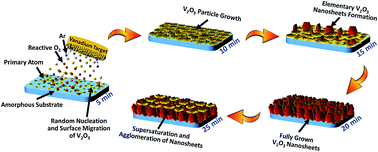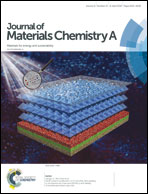Template-free synthesis of vanadium sesquioxide (V2O3) nanosheets and their room-temperature sensing performance†
Abstract
Until recently, it has been relatively hard to prepare vertically aligned vanadium sesquioxide (V2O3) nanosheets on glass substrates due to their extreme sensitivity to the atmosphere, doping, external pressure, and temperature. In this study, we present a simple one-step sputtering technique for the preparation of high-density vertically aligned V2O3 nanosheets on glass substrates without the use of any catalyst or template. To date, this structure has not been achieved using the V2O3 phase through sputtering. The definite oxidation state and phase of V2O3 with V3O5 inclusions were confirmed from the binding energies of the V2p3/2 and O1s peaks via X-ray photoelectron spectroscopy (XPS). The growth mechanism of nanosheets has been briefly explained. In this way, hierarchical V2O3 nanosheets interconnected with each other, which would allow easy electron transport between electrodes, favour remarkable sensing performance. The nanosheets exhibited trace-level ammonia (NH3) detection under ambient conditions for a wide concentration range of 10–500 ppm. Moreover, the selectivity and stability of the V2O3 nanosheets was studied. The present study may permit the design and fabrication of new electronic materials with multiple advantages based on V2O3 nanosheets.



 Please wait while we load your content...
Please wait while we load your content...